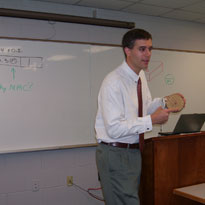TRIZ for Systematic Innovation
- Course:TRIZ for Systematic Innovation
- Course ID:TRIZ3D Duration:3 days Where: Your Office (7+ Persons)
- Download Course Description (PDF)
Available as a private, customized course for your group at your offices or ours and in some cases as a WebLive(TM) class.
Course Outline
TRIZ for Systematic Innovation
TRIZ for Systematic Innovation – Day 1: Introductory Concepts, TRIZ, and Functional Analysis
- Introduction and Course Overview. TRIZ historical context. Genrich Altshuller. Teoriza Rezhinija Izobretatalskih Zadach (TRIZ): The Theory of Inventive Problem Solving. System value, the S-Curve and ideality.
- Functional Analysis. Building to full system insight through: functional language, component analysis, and functional modeling.
- Group activity: Build a functional model of a system of your choice
TRIZ for Systematic Innovation – Day 2: System Trimming, Radical Trimming, Resource Analysis and Technical Contradictions
- System Trimming / Radical Trimming. Learn to advance system’s value by removing components while maintaining overall system functionality. Make leaps towards ideal systems by performing radical trimming and then develop designs to realize those systems.
- Group activity: Trim your function model to increase its value and radically trim your system to leap towards a state of ideality.
- Resource Analysis. Discover and utilize hidden solution resources around and within your systems. Find and apply alternative interaction fields, and other unused component and energy resources contained within your system of analysis and hidden within the surrounding operational environment.
- Group activities:
- Save the Titanic passengers.
- Identify alternative interaction fields by which to support the radical trimming exercise.
- Technical Contradictions: Learn to reflect contradictory system requirements in compact and effective statements that focus your attention on the principal aspects of your problems. Understand how to recognize and capture contradictions in your functional models. Utilize the contradiction matrix to identify selected principles applicable to your technical contradictions. Apply the selected principles in solving your contradictory requirements.
- Group activity: Identify and capture technical contradictions found in your class project and/or case study systems. Solve those technical contradictions
TRIZ for Systematic Innovation – Day 3: Physical Contradictions, Introduction to TRIZ and Patent Strategies, Trends of Engineering System Evolution Introduction
- Physical Contradictions. Model contradictory system requirements by way of physical contradiction statements and utilize the separation, satisfaction, and by-pass algorithm to solve your physical contradictions.
- Group activity: Identify and capture physical contradictions found in your class project and/or case study systems. Solve those physical contradictions
- TRIZ and Patent Strategies. Learn the relationship between various TRIZ concepts and certain patent strategies: Trimming, Circumvention Resources Analysis, Doctorine of Equivalency.
- Trends of Engineering System Evolution. An advanced introduction to the fascinating world of the Trends of System Evolution.
- Group activity: Using the introduced trends, generate possible innovations for your project.
- TRIZ for Systematic Innovation – Course Wrap-Up. Course review. Topics for further study. Questions and answers. Plans for future actions. Course critique.
DCN FrTZ.f
Course in a Nutshell
TRIZ is an empirically proven innovation technique based on a 75-year study of 4+ million global patents. While experts can apply TRIZ to almost any challenge, this overview will help you tackle product design and advancement, manufacturing (or other process) improvement, patent circumvention and protection, and other problems that require innovating systems of interacting components, whether an automobile wheel or a particle accelerator.
Upon completing TRIZ for Systematic Innovation, you will be able to functionally analyze your engineering systems, recognize contradictory requirements within those systems, and identify principles and system resources you can use to resolve those contradictions and the advancement of the ideality of those systems. You will also be able to enhance the value of your systems by removing components while maintaining system functionality, use TRIZ to support your patenting strategies, and have gained insight into the ubiquitous trends of system evolution.
Customize It!
Whatever the nature of your systems, processes, products, or services, we will customize the course to meet your specific objectives. Here are some of the ways in which we can tailor the TRIZ for Systematic Innovation course to help you get more out of it:
- We can tailor our examples and exercises to your industry. It may also be possible for the participants to work on some of their own projects in class.
- Added “workshop days” (at the end of or a few weeks after the class) present the opportunity to use TRIZ to generate solutions for your own issues under the guidance of a TRIZ expert.
- Schedule post-class follow-up consultation for continuing your in-house TRIZ implementation.
Learn How To
- Work together as a team to understand and implement the TRIZ concepts and techniques.
- Drive a system towards its ideal state
- Fully understand systems at a functional level
- Trim systems to improve their value
- Use TRIZ to identify and overcome conflicting system requirements (i.e., design contradictions).
- Apply system and super-system resources to solve challenging problems.
- Employ proven inventive procedures to find innovative solutions to your product and process design challenges.
Aimed At
Engineers (all disciplines), designers, strategists, and others charged with creating innovative products, processes, systems, or services as well as those who work with them or manage their work will all benefit from the TRIZ for Systematic Innovation course.
Prerequisites
While there are no formal prerequisites, the TRIZ for Systematic Innovation course assumes an engineering, design/development, manufacturing, or technical background.

